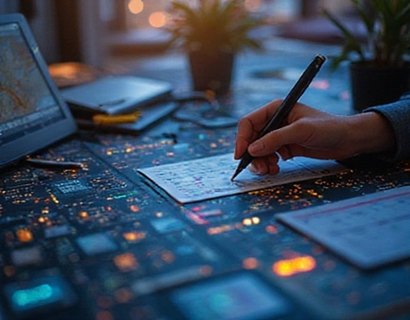Unleashing Next-Gen Productivity with Advanced Digital Solutions: The Convergence of Crypto and AI
The intersection of cryptocurrency and artificial intelligence (AI) is giving rise to a new era of digital transformation, one that promises to revolutionize the way we approach productivity and daily tasks. This convergence is not just a technological curiosity but a powerful force that is reshaping industries and empowering tech enthusiasts and early adopters. As we delve into this exciting space, it's essential to understand how these two cutting-edge technologies are coming together to create advanced applications and services that simplify and enhance our digital lives.
The foundation of this transformation lies in the unique properties of blockchain technology, the underlying infrastructure of cryptocurrency. Blockchain's decentralized, transparent, and secure nature provides an ideal platform for developing trustless and efficient systems. When combined with AI, which excels in pattern recognition, data analysis, and autonomous decision-making, the potential for innovation becomes immense. This synergy is giving birth to a new generation of digital solutions that are more intelligent, responsive, and user-friendly than ever before.
Enhancing Productivity through AI-Driven Crypto Applications
One of the most significant impacts of this convergence is in the realm of productivity tools. Traditional productivity applications are being reimagined with AI and blockchain to offer features that were once the stuff of science fiction. For instance, smart contracts on the blockchain can automate and enforce contractual obligations without the need for intermediaries, reducing administrative overhead and ensuring compliance. AI can further optimize these processes by predicting potential issues and suggesting efficient workflows.
Consider a scenario where a team of developers is working on a cross-border project. Using an AI-powered blockchain application, they can automate payment transactions, manage intellectual property rights, and ensure that all parties adhere to the agreed terms. The AI component analyzes real-time data to optimize the workflow, identify bottlenecks, and provide actionable insights, all while the blockchain ensures that every step is recorded and verifiable.
Streamlining Daily Tasks with Intelligent Assistants
Beyond professional applications, the combination of AI and cryptocurrency is also transforming personal productivity tools. Intelligent assistants powered by AI can manage your schedule, prioritize tasks, and even handle routine inquiries, all while leveraging the security and privacy features of blockchain. These assistants can be funded and incentivized using cryptocurrency, creating a seamless and secure user experience.
Imagine having a personal assistant that not only keeps you organized but also rewards you with cryptocurrency for completing tasks efficiently. This not only motivates better performance but also aligns your interests with the goals of the system. The data you generate through these interactions can be securely stored on the blockchain, giving you full control over your personal information while providing valuable insights to the AI for continuous improvement.
Decentralized Marketplaces and Community-Driven Innovation
The convergence of AI and cryptocurrency is also giving rise to decentralized marketplaces where creators and users can interact directly, without the need for centralized platforms. These marketplaces leverage blockchain to ensure fair compensation and transparency, while AI enhances the user experience by recommending products, matching suppliers and buyers, and optimizing supply chains.
In these decentralized ecosystems, AI-driven analytics can help identify trends, predict demand, and optimize pricing. This data-driven approach ensures that the marketplace remains dynamic and responsive to user needs. Moreover, the use of cryptocurrency in these platforms eliminates the need for traditional payment systems, reducing transaction costs and increasing accessibility for a global audience.
Case Study: A Decentralized Creative Marketplace
Consider a decentralized creative marketplace where artists, writers, and developers can showcase and sell their work directly to consumers. The platform uses AI to curate content based on user preferences and past interactions, ensuring a personalized experience. Transactions are handled through a native cryptocurrency, with smart contracts automatically managing royalties and payments. The AI system analyzes market data to provide insights on trending topics and emerging talents, helping creators stay relevant and successful.
This model not only empowers creators by giving them more control over their work and earnings but also provides consumers with a richer and more diverse range of content. The decentralized nature of the platform ensures that it is resilient to censorship and manipulation, fostering a truly open and innovative environment.
Security and Privacy in AI-Crypto Applications
One of the most compelling aspects of using AI and blockchain together is the enhanced security and privacy they offer. Blockchain's immutable ledger ensures that data once recorded cannot be altered or deleted, providing a tamper-proof record of transactions and interactions. AI, with its advanced encryption and anomaly detection capabilities, further fortifies this security by identifying and mitigating potential threats in real-time.
For users, this means that their personal and financial data is protected against breaches and unauthorized access. Transactions are secure, and privacy is maintained, as sensitive information is encrypted and stored decentralized on the blockchain. This level of security is particularly crucial in an era where data breaches and cyber attacks are increasingly common.
Challenges and Considerations
Despite the numerous benefits, the integration of AI and cryptocurrency is not without its challenges. One of the primary concerns is the regulatory landscape. As these technologies are still relatively new, regulations are evolving and can vary significantly across different regions. Developers and businesses must navigate this complex environment to ensure compliance while innovating.
Another challenge is the technical complexity involved in building and maintaining AI-crypto applications. Developing systems that can handle the computational demands of AI while ensuring the security and efficiency of blockchain requires expertise in multiple domains. However, as the ecosystem matures, tools and frameworks are becoming more accessible, making it easier for developers to create robust solutions.
The Future of AI-Crypto Integration
Looking ahead, the future of AI and cryptocurrency integration is bright, with numerous exciting developments on the horizon. One area of focus is the development of more sophisticated AI models that can run efficiently on blockchain networks. This could lead to the creation of decentralized AI services that are not only powerful but also cost-effective and accessible to a broader audience.
Another promising direction is the integration of AI with other emerging technologies such as the Internet of Things (IoT) and 5G networks. This convergence could enable smart, autonomous systems that optimize resource usage, enhance user experiences, and drive further innovation. The potential applications are vast, ranging from smart cities to advanced healthcare solutions.
As the technology continues to evolve, we can expect to see more user-friendly interfaces and applications that seamlessly integrate AI and blockchain. The goal is to make these advanced digital solutions accessible to everyone, not just tech enthusiasts and early adopters. By demystifying the technology and providing intuitive tools, we can empower a wider audience to benefit from the transformative power of AI and cryptocurrency.
In conclusion, the convergence of AI and cryptocurrency is not just a technological trend but a fundamental shift in how we approach productivity and digital interactions. By leveraging the strengths of both technologies, we can create a more efficient, secure, and user-centric digital world. As we continue to explore this exciting frontier, the possibilities are endless, and the future looks incredibly promising.










































